|
News Archive: Jan. 1-31 |

|
Neutron star swaps lead to short gamma-ray bursts
Gamma-ray bursts are the most powerful explosions in the universe, emitting huge amounts of high-energy radiation. For decades their origin was a mystery. Scientists now believe they understand the processes that produce gamma-ray bursts. However, a new study suggests a previously overlooked source for some gamma-ray bursts: stellar encounters within globular clusters.
 FULL STORY FULL STORY
 |  |

|
 |
New propulsion engine tested with non-toxic fuels
NASA engineers have successfully tested a new breed of reaction control engine and propulsion system. Aimed at furthering NASA's space exploration goals, the tests helped investigate the possibility of future space travel fueled by non-toxic propellants.
 FULL STORY FULL STORY
 |  |

|
 |
Lockheed gets contract for third A-EHF satellite
The U.S. Air Force has awarded Lockheed Martin a contract for $491 million to build a third spacecraft for the Advanced Extremely High Frequency (Advanced EHF) program constellation. Advanced EHF satellites will provide global, highly secure, protected, survivable communications for all warfighters serving under the U.S. Department of Defense.
 FULL STORY FULL STORY
 |  |

|
 |
Most stars in the Milky Way are single, study shows
Common wisdom among astronomers holds that most star systems in the Milky Way are multiple, consisting of two or more stars in orbit around each other. Common wisdom is wrong. A new study demonstrates that most star systems are made up of single stars. Since planets probably are easier to form around single stars, planets also may be more common than previously suspected.
 FULL STORY FULL STORY
 |  |
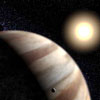
|
 |
New Horizons adjusts its trajectory with maneuvers
NASA's New Horizons spacecraft has successfully carried out its first post-launch maneuvers, conducting two small thruster firings that slightly adjusted its path toward the outer solar system and the first close-up study of distant planet Pluto.
 FULL STORY FULL STORY
 |  |

|
 |
Stardust mothership now asleep with unknown future
NASA's Stardust spacecraft has been placed into hibernation mode, two weeks after successfully dispatching its comet sample return capsule on course for Earth. The instrument-laden mothership remains in space with the chance of being reused for a future science mission.
 FULL STORY FULL STORY
 |  |

|
 |
OTHER HEADLINES Additional stories today
|
 |
NASA test provides pilots with better weather forecasts -- Weather forecasters in the middle of the United States are making better local predictions for pilots and others thanks to an airborne sensor being tested by NASA's Aviation Safety Program.
|
 |
Potential mission to Mars seeks underground water
A bold robotic mission to Mars, called THOR, proposes to make the first exploration of subsurface water ice in a potentially habitable zone. Envisioned for launch in 2011, THOR will use a direct approach to excavating material from beneath the surface of Mars: blasting it out. A projectile would be sent at high speed into the martian surface while observing the impact and its aftermath.
 FULL STORY FULL STORY
 |  |
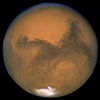
|
 |
Delta rocket workers set to vote on ending strike
A strike by Boeing machinists that has grounded the Delta rocket fleet for nearly three months could be edging closer to resolution. Negotiations between the company and union leaders have resulted in a revised contract offer that will be put to a vote on Wednesday.
 FULL STORY FULL STORY
 |  |

|
 |
20 years after Challenger
On a bitterly cold January morning 20 years ago Saturday, space shuttle Challenger and her seven-member crew made a fateful voyage into history. Spaceflight Now marks the anniversary with a comprehensive timeline of the events and video of that day.
 CHALLENGER TIMELINE CHALLENGER TIMELINE
 |  |
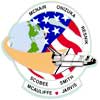
|
 |

Additional coverage for subscribers:
 VIDEO:
SATURDAY'S 20TH ANNIVERSARY SERVICE: VIDEO:
SATURDAY'S 20TH ANNIVERSARY SERVICE:
DIAL-UP: part 1 | part 2
BROADBAND: part 1 | part 2 | part 3
 AUDIO:
LISTEN TO THE MEMORIAL SERVICE FOR IPOD AUDIO:
LISTEN TO THE MEMORIAL SERVICE FOR IPOD
 SUBSCRIBE NOW SUBSCRIBE NOW

|
Environmental satellite brought back from the brink
Two months shy of its 22nd birthday, the Landsat 5 Earth observatory has a new lease on life after controllers dodged a potentially fatal bullet involving a crucial mechanism in charge of pivoting the craft's solar array.
 FULL STORY FULL STORY
 |  |

|
 |
Former astronaut to lead advanced rocket concept
NASA has signed an agreement with Houston-based Ad Astra Rocket Co. that paves the way for commercialization of a promising advanced plasma rocket system that has evolved over the past 25 years.
 FULL STORY FULL STORY
 |  |

|
 |
Two 'exiled' stars are leaving Milky Way forever
TV reality show contestants aren't the only ones under threat of exile. Astronomers using the MMT Observatory in Arizona have discovered two stars exiled from the Milky Way galaxy. Those stars are racing out of the Galaxy at speeds of more than 1 million miles per hour - so fast that they will never return.
 FULL STORY FULL STORY
 |  |

|
 |
Mars rovers star in new IMAX movie spectacular
Thanks to a combination of coincidence, luck and a few handy connections, the Red Planet is a star in the story of the durable twin Mars rovers, which hits the extra-big screens in IMAX theaters in New York, Washington, D.C., and two dozen other cities across North America on Friday.
 FULL STORY FULL STORY
 |  |
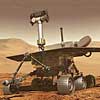
|
 |
OTHER HEADLINES Additional stories today
|
 |
NASA loans engine to industry partner -- NASA is loaning a rocket engine to Rocketplane Limited as part of an innovative industry partnership program. The Johnson Space Center and the company signed a Space Act Agreement for use of an RS-88 engine in tests of its Rocketplane XP vehicle for three years.
|
 |
Astronomers find smallest extrasolar planet yet
Using a relatively new planet-hunting technique that can spot worlds one-tenth the mass of our own, researchers have discovered a potentially rocky, icy body that may be the smallest planet yet found orbiting a star outside our solar system.
 FULL STORY FULL STORY
 |  |
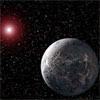
|
 |
NASA technology in new anti-icing windshield spray
A new product using a NASA-based technology might make winter just a little easier to endure for those living in parts of the U.S. where snow and ice are common.
 FULL STORY FULL STORY
 |  |

|
 |
OTHER HEADLINES Additional stories today
|
 |
Vandenberg preps for another year of flawless launches -- The 2006 launch schedule for Vandenberg is looking to be the busiest in six years, with twice the launches planned as last year, according to the 30th Space Wing Plans office.

Anomaly leads to retirement of Galaxy 3R satellite -- PanAmSat has announced that the Galaxy 3R domestic satellite, operating in an inclined orbit at 74 deg W, experienced an anomaly of its secondary spacecraft control processor. PanAmSat and the satellite manufacturer, Boeing, are continuing to investigate the anomaly.
|
 |
Twin Mars rovers still exploring after two years
With a longevity unthinkable even to the humans that built them, NASA's remarkable Mars rovers remain hard at work after two years on the Red Planet's surface. Both motorized robots are still going strong in their continued scientific pursuits.
 FULL STORY FULL STORY
 |  |

|
 |

Additional coverage for subscribers:
 VIDEO:
TUESDAY'S ROVER ANNIVERSARY CELEBRATION: VIDEO:
TUESDAY'S ROVER ANNIVERSARY CELEBRATION:
DIAL-UP | BROADBAND part 1 and part 2

A LOOK BACK TO SPIRIT'S LANDING:
 VIDEO: BEHIND THE SCENES AT MOMENT OF TOUCHDOWN QT VIDEO: BEHIND THE SCENES AT MOMENT OF TOUCHDOWN QT
 VIDEO: CHEERS AND SCREAMS WHEN SPIRIT CONFIRMED ALIVE QT VIDEO: CHEERS AND SCREAMS WHEN SPIRIT CONFIRMED ALIVE QT
 VIDEO: THE LIVE SPIRIT ROVER LANDING COVERAGE QT VIDEO: THE LIVE SPIRIT ROVER LANDING COVERAGE QT
 VIDEO: THE SUCCESSFUL LANDING DESCRIBED AT NEWS BRIEFING QT VIDEO: THE SUCCESSFUL LANDING DESCRIBED AT NEWS BRIEFING QT
 VIDEO: FIRST IMAGES ARE DISCUSSED AT OVERNIGHT CONFERENCE QT VIDEO: FIRST IMAGES ARE DISCUSSED AT OVERNIGHT CONFERENCE QT
 VIDEO: ANIMATION OF SPIRIT'S DESCENT WITH NARRATION QT VIDEO: ANIMATION OF SPIRIT'S DESCENT WITH NARRATION QT
 VIDEO: DESCENT RE-ENACTMENT USING REAL DATA W/NARRATION QT VIDEO: DESCENT RE-ENACTMENT USING REAL DATA W/NARRATION QT
 VIDEO: SPIRIT LANDING SITE & HARDWARE SEEN FROM ORBIT QT VIDEO: SPIRIT LANDING SITE & HARDWARE SEEN FROM ORBIT QT

A LOOK BACK TO OPPORTUNITY'S LANDING:
 VIDEO: CONTROLLERS ANNOUNCE CRUISE STAGE JETTISON QT VIDEO: CONTROLLERS ANNOUNCE CRUISE STAGE JETTISON QT
 VIDEO: LIVE LANDING COVERAGE FROM ENTRY TO TOUCHDOWN QT VIDEO: LIVE LANDING COVERAGE FROM ENTRY TO TOUCHDOWN QT
 VIDEO: OPPORTUNITY'S FIRST IMAGES RECEIVED ON EARTH QT VIDEO: OPPORTUNITY'S FIRST IMAGES RECEIVED ON EARTH QT
 VIDEO: FIRST COLOR IMAGERY FROM OPPORTUNITY UNVEILED QT VIDEO: FIRST COLOR IMAGERY FROM OPPORTUNITY UNVEILED QT
 VIDEO: SCIENCE LEADER NARRATES THE FIRST BATCH OF IMAGES QT VIDEO: SCIENCE LEADER NARRATES THE FIRST BATCH OF IMAGES QT
 VIDEO: POST-LANDING NEWS CONFERENCE QT VIDEO: POST-LANDING NEWS CONFERENCE QT
 SUBSCRIBE NOW SUBSCRIBE NOW

|
The mark of a dying star
Six hundred and fifty light-years away in the constellation Aquarius, a dead star about the size of Earth, is refusing to fade away peacefully. In death, it is spewing out massive amounts of hot gas and intense ultraviolet radiation, creating a spectacular object called a "planetary nebula."
 FULL STORY FULL STORY
 |  |

|
 |
H-2A launch photo gallery
This collection of pictures shows the Japanese H-2A rocket being rolled to its pad and then launching the Advanced Land Observation Satellite. Images include views taken from onboard cameras mounted to the rocket.
 ENTER PHOTO GALLERY ENTER PHOTO GALLERY
 |  |

|
 |
New Earth observer satellite launched into orbit
A first-class, four-ton Earth remote sensing satellite was orbited by Japan on Tuesday, setting off on a mission to help cartographers create more precise maps on a global scale, scientists in their search for natural resources and officials in response to disasters.
 FULL STORY FULL STORY
 |  |

|
 |
Spying Titan's weather
Using recent Cassini, Huygens and Earth-based observations, scientists have been able to create a computer model which explains the formation of several types of ethane and methane clouds on Titan.
 FULL STORY FULL STORY
 |  |

|
 |
Moons in perspective
Two of Saturn's battered, icy companions hover here in this Cassini image, above the planet's ringplane. To get a sense of the three-dimensional nature of the scene, note that the wide band of visible rings is in between the two moons in this view. Mimas is outside the far side of the rings. Dione is outside the rings and closest to Cassini.
 FULL STORY FULL STORY
 |  |

|
 |
More pictures, video from New Horizons launch
As we wrap up the launch portion of our New Horizons coverage, we have posted some additional photo galleries of the Lockheed Martin Atlas 5 rocket blasting off. Also, various replays of the launch from pad cameras and ground trackers are available with the live liftoff audio and commentary in our Spaceflight Now Plus premium service.
 IMAGES: LOCKHEED MARTIN (part 1) IMAGES: LOCKHEED MARTIN (part 1)
 IMAGES: LOCKHEED MARTIN (part 2) - new! IMAGES: LOCKHEED MARTIN (part 2) - new!
 IMAGES: SPACEFLIGHT NOW'S PHOTOS IMAGES: SPACEFLIGHT NOW'S PHOTOS
 IMAGES: NASA'S LAUNCH PICTURES - new! IMAGES: NASA'S LAUNCH PICTURES - new!
 VIDEO COVERAGE VIDEO COVERAGE
 ATLAS LAUNCH ARCHIVE ATLAS LAUNCH ARCHIVE
 |  |

|
 |

Additional coverage for subscribers:
 VIDEO:
THE ATLAS 5 LAUNCH EXPERIENCE SMALL | MEDIUM | LARGE VIDEO:
THE ATLAS 5 LAUNCH EXPERIENCE SMALL | MEDIUM | LARGE
 VIDEO:
LAUNCH PAD BASE CAMERA PLAY VIDEO:
LAUNCH PAD BASE CAMERA PLAY
 VIDEO:
FACING THE FLAME TRENCH PLAY VIDEO:
FACING THE FLAME TRENCH PLAY
 VIDEO:
CLOSE-UP OF BOOSTERS AT IGNITION PLAY VIDEO:
CLOSE-UP OF BOOSTERS AT IGNITION PLAY
 VIDEO:
CAMERA ON ATLAS 5 ASSEMBLY HANGAR PLAY VIDEO:
CAMERA ON ATLAS 5 ASSEMBLY HANGAR PLAY
 VIDEO:
ROOF OF SPACE SHUTTLE VEHICLE ASSEMBLY BUILDING PLAY VIDEO:
ROOF OF SPACE SHUTTLE VEHICLE ASSEMBLY BUILDING PLAY
 VIDEO:
TRACKER MONITORS ENGINES DURING FLIGHT PLAY VIDEO:
TRACKER MONITORS ENGINES DURING FLIGHT PLAY
 VIDEO:
THE UCS 15 GROUND TRACKING CAMERA PLAY VIDEO:
THE UCS 15 GROUND TRACKING CAMERA PLAY
 VIDEO:
PLAYALINDA BEACH TRACKER FOLLOWS ROCKET PLAY VIDEO:
PLAYALINDA BEACH TRACKER FOLLOWS ROCKET PLAY
 VIDEO:
TRACKER SHOWS THE VEHICLE'S ROLL PROGRAM PLAY VIDEO:
TRACKER SHOWS THE VEHICLE'S ROLL PROGRAM PLAY
 VIDEO:
VIEW FROM SHUTTLE COUNTDOWN CLOCK PLAY VIDEO:
VIEW FROM SHUTTLE COUNTDOWN CLOCK PLAY
 SUBSCRIBE NOW SUBSCRIBE NOW

|
Two new planetary disks may mirror our Kuiper Belt
A survey by NASA's Hubble Space Telescope of 22 nearby stars has turned up two with bright debris disks that appear to be the equivalent of our own solar system's Kuiper Belt, a ring of icy rocks outside the orbit of Neptune and the source of short-period comets.
 FULL STORY FULL STORY
 |  |

|
 |
Origin of glaciers on Mars
The spectacular features visible today on the surface of the Red Planet indicate the past existence of Martian glaciers, but where did the ice come from? An international team of scientists have produced sophisticated climate simulations suggesting that geologically recent glaciers at low latitudes may have formed through atmospheric precipitation of water-ice particles.
 FULL STORY FULL STORY
 |  |

|
 |
Magnetic field mission ends
NASA's Imager for Magnetopause-to-Aurora Global Exploration (IMAGE) satellite recently ceased operations, bringing to a close a successful six-year mission. IMAGE was the premier producer of new discoveries on the structure and dynamics of the Earth's external magnetic field and its contents.
 FULL STORY FULL STORY
 |  |

|
 |
Probe sets sail on voyage to the outer solar system
A supercharged Atlas 5 rocket carrying NASA's Pluto-bound New Horizons probe roared to life and vaulted away from Earth Thursday on a three-billion-mile, nine-year voyage to the frigid edge of the solar system.
 FULL STORY FULL STORY
 MISSION STATUS CENTER - live updates MISSION STATUS CENTER - live updates
 IMAGES: ATLAS 5 ON THE PAD IMAGES: ATLAS 5 ON THE PAD
 IMAGES: LAUNCH OF NEW HORIZONS! IMAGES: LAUNCH OF NEW HORIZONS!
 IMAGES: MORE LAUNCH PHOTOS IMAGES: MORE LAUNCH PHOTOS
 VIDEO COVERAGE VIDEO COVERAGE
 |  |

|
 |

Additional coverage for subscribers:
 VIDEO:
LIFTOFF OF NEW HORIZONS! SHORT | LONGER VIDEO:
LIFTOFF OF NEW HORIZONS! SHORT | LONGER
 VIDEO:
LAUNCH AS SEEN FROM THE PRESS SITE PLAY VIDEO:
LAUNCH AS SEEN FROM THE PRESS SITE PLAY
 VIDEO:
ALL FIVE SOLID ROCKET BOOSTERS JETTISON PLAY VIDEO:
ALL FIVE SOLID ROCKET BOOSTERS JETTISON PLAY
 VIDEO:
NEW HORIZONS IS DEPLOYED FROM THIRD STAGE PLAY VIDEO:
NEW HORIZONS IS DEPLOYED FROM THIRD STAGE PLAY
 VIDEO:
POST-FLIGHT INTERVIEW WITH NASA LAUNCH MANAGER PLAY VIDEO:
POST-FLIGHT INTERVIEW WITH NASA LAUNCH MANAGER PLAY
 VIDEO:
WATCH POST-LAUNCH NEWS BRIEFING DIAL-UP | BROADBAND VIDEO:
WATCH POST-LAUNCH NEWS BRIEFING DIAL-UP | BROADBAND
 AUDIO:
LISTEN TO THE NEWS CONFERENCE FOR iPOD AUDIO:
LISTEN TO THE NEWS CONFERENCE FOR iPOD

 VIDEO:
NARRATED FOOTAGE OF ATLAS 5'S LAUNCH CAMPAIGN PLAY VIDEO:
NARRATED FOOTAGE OF ATLAS 5'S LAUNCH CAMPAIGN PLAY
 VIDEO:
NARRATED FOOTAGE OF NEW HORIZON'S CAMPAIGN PLAY VIDEO:
NARRATED FOOTAGE OF NEW HORIZON'S CAMPAIGN PLAY
 VIDEO:
TUESDAY'S LAUNCH ATTEMPT IS SCRUBBED PLAY VIDEO:
TUESDAY'S LAUNCH ATTEMPT IS SCRUBBED PLAY
 SUBSCRIBE NOW SUBSCRIBE NOW

|
Stardust probe loaded with primordial debris
NASA's Stardust probe returned to Earth last weekend loaded with primordial debris from an ancient comet, researchers said Thursday, providing an unprecedented glimpse into the birth of the solar system 4.6 billion years ago.
 FULL STORY FULL STORY
 |  |

|
 |

Additional coverage for subscribers:
 VIDEO:
WATCH THURSDAY'S NEWS BRIEFING PLAY VIDEO:
WATCH THURSDAY'S NEWS BRIEFING PLAY
 AUDIO:
LISTEN TO THE NEWS CONFERENCE FOR iPOD AUDIO:
LISTEN TO THE NEWS CONFERENCE FOR iPOD
 SUBSCRIBE NOW SUBSCRIBE NOW

|
Stardust's cosmic paydirt
Scientists at the Johnson Space Center in Houston were excited and awed Tuesday by what they saw when the sample-return canister from the Stardust spacecraft was opened.
 FULL STORY FULL STORY
 |  |

|
 |
Storm escapes the shadows
A great storm swims in the cloud lanes of Saturn's high northern latitudes in this Cassini picture. Dark bands across the bottom of this view are shadows cast by the partly opaque rings. Cloud features are visible within the shadow of the A ring.
 FULL STORY FULL STORY
 |  |

|
 |
Fossil galaxy reveals clues to early universe
A tiny galaxy has given astronomers a glimpse of a time when the first bright objects in the universe formed, ending the dark ages that followed the birth of the universe.
 FULL STORY FULL STORY
 |  |

|
 |
OTHER HEADLINES Additional stories today
|
 |
Telesat unveils plans for new digital TV satellite -- Canada's Telesat has announced plans to build and launch Nimiq 4, a new direct broadcast satellite that will carry a wide range of digital television services. Telesat has selected EADS Astrium as the manufacturer for Nimiq 4, and International Launch Services for the satellite's launch on a Proton rocket.
|
 |
First mission to 9th planet
New Horizons was built to become the first robotic explorer to visit Pluto and probe the Kuiper Belt in the outskirts of the planetary neighborhood. Check out this highly-detailed five-part preview story examining NASA's New Horizons mission.
 FULL REPORT FULL REPORT
 LAUNCH GROUND TRACK LAUNCH GROUND TRACK
 THE SCIENCE GOALS THE SCIENCE GOALS
 SPACECRAFT FACT SHEET SPACECRAFT FACT SHEET
 |  |

|
 |
Pluto-bound probe rolls out to the pad on eve of launch
A grand adventure to explore the outer frontier of the solar system was moved to the launch pad Monday morning for the final day of preparations leading to blastoff.
 FULL STORY FULL STORY
 IMAGES: MONDAY MORNING'S ROLLOUT IMAGES: MONDAY MORNING'S ROLLOUT
 |  |

|
 |

Additional coverage for subscribers:
 VIDEO:
ATLAS 5 ROCKET ROLLS TO PAD WITH NEW HORIZONS PLAY VIDEO:
ATLAS 5 ROCKET ROLLS TO PAD WITH NEW HORIZONS PLAY
 VIDEO:
TIME-LAPSE VIDEO OF THE ROLLOUT PLAY VIDEO:
TIME-LAPSE VIDEO OF THE ROLLOUT PLAY

 VIDEO:
SUNDAY'S PRE-LAUNCH NEWS BRIEFING DIAL-UP | BROADBAND VIDEO:
SUNDAY'S PRE-LAUNCH NEWS BRIEFING DIAL-UP | BROADBAND
 VIDEO:
ANIMATED ATLAS 5 LAUNCH PREVIEW WITH NARRATION PLAY VIDEO:
ANIMATED ATLAS 5 LAUNCH PREVIEW WITH NARRATION PLAY
 VIDEO:
NEW HORIZONS SCIENCE BRIEFING DIAL-UP | BROADBAND VIDEO:
NEW HORIZONS SCIENCE BRIEFING DIAL-UP | BROADBAND
 VIDEO:
SCIENCE INSTRUMENTS BRIEFING-PART 1 DIAL-UP | BROADBAND VIDEO:
SCIENCE INSTRUMENTS BRIEFING-PART 1 DIAL-UP | BROADBAND
 VIDEO:
SCIENCE INSTRUMENTS BRIEFING-PART 2 DIAL-UP | BROADBAND VIDEO:
SCIENCE INSTRUMENTS BRIEFING-PART 2 DIAL-UP | BROADBAND

 VIDEO:
NEW HORIZONS MOUNTED ATOP THE ATLAS 5 PLAY VIDEO:
NEW HORIZONS MOUNTED ATOP THE ATLAS 5 PLAY
 VIDEO:
SPACECRAFT TRAVELS TO ROCKET ASSEMBLY BUILDING PLAY VIDEO:
SPACECRAFT TRAVELS TO ROCKET ASSEMBLY BUILDING PLAY
 VIDEO:
MISSION LOGO APPLIED TO THE ATLAS 5'S FAIRING PLAY VIDEO:
MISSION LOGO APPLIED TO THE ATLAS 5'S FAIRING PLAY
 VIDEO:
SPACECRAFT ENCAPSULED WITHIN ROCKET NOSE CONE PLAY VIDEO:
SPACECRAFT ENCAPSULED WITHIN ROCKET NOSE CONE PLAY
 SUBSCRIBE NOW SUBSCRIBE NOW

|
Welcome home, Stardust!
The 7-year voyage of NASA's Stardust mission to retrieve pristine samples of a comet has returned to Earth, parachuting to the ground in Utah on Sunday after a 2.88 billion mile journey through the solar system.
 FULL STORY FULL STORY
 MISSION STATUS CENTER MISSION STATUS CENTER
 LANDING PREVIEW LANDING PREVIEW
 FROM 2004: COVERAGE OF COMET ENCOUNTER FROM 2004: COVERAGE OF COMET ENCOUNTER
 FROM 1999: THE LAUNCH OF STARDUST FROM 1999: THE LAUNCH OF STARDUST
 |  |

|
 |

Additional coverage for subscribers:
 VIDEO:
POST-LANDING NEWS CONFERENCE DIAL-UP | BROADBAND VIDEO:
POST-LANDING NEWS CONFERENCE DIAL-UP | BROADBAND
 AUDIO:
LISTEN TO THE POST-LANDING BRIEFING FOR iPOD AUDIO:
LISTEN TO THE POST-LANDING BRIEFING FOR iPOD
 VIDEO:
LANDING AS SEEN LIVE VIA INFRARED TRACKING CAMERAS PLAY VIDEO:
LANDING AS SEEN LIVE VIA INFRARED TRACKING CAMERAS PLAY
 VIDEO:
SAMPLE CAPSULE RELEASED FROM MOTHERSHIP PLAY VIDEO:
SAMPLE CAPSULE RELEASED FROM MOTHERSHIP PLAY

 VIDEO:
THURSDAY'S PRE-LANDING BRIEFING DIAL-UP | BROADBAND VIDEO:
THURSDAY'S PRE-LANDING BRIEFING DIAL-UP | BROADBAND
 VIDEO:
RETURN PREVIEW NEWS BRIEFING DIAL-UP | BROADBAND VIDEO:
RETURN PREVIEW NEWS BRIEFING DIAL-UP | BROADBAND
 SUBSCRIBE NOW SUBSCRIBE NOW

|
Kuiper belt moons are starting to seem typical
In the not-too-distant past, the planet Pluto was thought to be an odd bird in the outer reaches of the solar system because it has a moon, Charon, that was formed much like Earth's own moon was formed. But Pluto is getting a lot of company these days. Of the four largest objects in the Kuiper belt, three have one or more moons.
 FULL STORY FULL STORY
 |  |

|
 |
Cartwheel Galaxy makes waves in new NASA image
A new picture from NASA's Galaxy Evolution Explorer completes a multi-wavelength, neon-colored portrait of the enormous Cartwheel galaxy after a smaller galaxy plunged through it, triggering ripples of sudden, brief star formation.
 FULL STORY FULL STORY
 |  |

|
 |
Galaxy survey yields new findings on star formation
New findings from a large survey of galaxies suggest that star formation is largely driven by the supply of raw materials, rather than by galactic mergers that trigger sudden bursts of star formation. Stars form when clouds of gas and dust collapse under the force of gravity, and the study supports a scenario in which exhaustion of a galaxy's gas supply leads to a gradual decline in the star-formation rate.
 FULL STORY FULL STORY
 |  |

|
 |
Space probes detect enormous magnetic event
A fleet of NASA and European Space Agency space-weather probes recently observed an immense jet of electrically charged particles in the solar wind between the sun and Earth. The jet, at least 200 times as wide as the Earth, was powered by clashing magnetic fields in a process known as "magnetic reconnection.
 FULL STORY FULL STORY
 |  |

|
 |
Hubble's view of Orion reveals thousands of stars
In one of the most detailed astronomical images ever produced, NASA's Hubble Space Telescope is offering an unprecedented look at the Orion Nebula. This turbulent star-formation region is one of astronomy's most dramatic and photogenic celestial objects.
 FULL STORY FULL STORY
 |  |

|
 |
Possible comet dust found around dead star
NASA's Spitzer Space Telescope has spotted what may be comet dust sprinkled around a white dwarf star that died approximately 500 million years ago. The findings suggest the star, which most likely consumed its inner planets, is still orbited by a ring of surviving comets and possibly outer planets.
 FULL STORY FULL STORY
 |  |

|
 |
Planet finders discover new world with fast device
Astronomers have discovered a planet orbiting a very young star nearly 100 light years away using a relatively small, publicly accessible telescope turbocharged with a new planet-finding instrument.
The feat suggests that astronomers have found a way to dramatically accelerate the pace of the hunt for planets outside our solar system.
 FULL STORY FULL STORY
 |  |

|
 |
Study notes role of hit-and-run collisions in formations
Hit-and-run collisions between embryonic planets during a critical period in the early history of the Solar System may account for some previously unexplained properties of planets, asteroids, and meteorites, according to researchers at the University of California, Santa Cruz.
 FULL STORY FULL STORY
 |  |
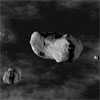
|
 |
Spitzer captures our galaxy's bustling center
A new infrared mosaic from NASA's Spitzer Space Telescope offers a stunning view of the stellar hustle and bustle that takes place at our Milky Way galaxy's center. The picture shows throngs of mostly old stars, on the order of hundreds of thousands, amid fantastically detailed clouds of glowing dust lit up by younger, massive stars.
 FULL STORY FULL STORY
 |  |

|
 |
Monster black holes grow after galactic mergers
An analysis of the Hubble Space Telescope's deepest view of the universe offers compelling evidence that monster black holes in the centers of galaxies were not born big but grew over time through repeated galactic mergers.
 FULL STORY FULL STORY
 |  |

|
 |
NASA's Chandra finds black holes stirring up galaxies
Black holes are creating havoc in unsuspected places, according to a new study of images of elliptical galaxies made by NASA's Chandra X-ray Observatory. The discovery of far-reaching explosive activity, due to giant central black holes in these old galaxies, was a surprise to astronomers.
 FULL STORY FULL STORY
 |  |

|
 |
OTHER HEADLINES Additional stories today
|
 |
Distinguished astronomer honored -- NASA Administrator Michael Griffin awarded the agency's Exceptional Scientific Achievement Medal posthumously to acclaimed American astronomer and astrophysicist John Bahcall. His lifetime of achievement included work on development of the Hubble Space Telescope.

NASA honors legendary astronaut Vance Brand -- NASA will honor former astronaut Vance Brand for his involvement in the Apollo space program with the presentation of the Ambassador of Exploration Award.
|
 |
There's more to the North Star than meets the eye
We tend to think of the North Star, Polaris, as a steady, solitary point of light that guided sailors in ages past. But there is more to the North Star than meets the eye. The North Star is actually a triple star system. And while one companion can be seen easily through small telescopes, the other hugs Polaris so tightly that it has never been seen - until now.
 FULL STORY FULL STORY
 |  |

|
 |
Scientists probe black hole's inner sanctum
How does matter spiral its way to the center of a galaxy and into the mouth of a supermassive black hole? A new study provides the best glimpse yet at the death spiral of material as it descends into the core of a galaxy hosting a large black hole. The study predicts that, barring obstructions, the galactic debris will take about 200,000 years to make a one-way trip through the inner regions of the galaxy and into oblivion.
 FULL STORY FULL STORY
 |  |

|
 |
'Point of no return' found for black hole
Scientists have found new evidence that black holes are performing the disappearing acts for which they are known. A team from MIT and Harvard has found that a certain type of X-ray explosion common on neutron stars is never seen around their black hole cousins, as if the gas that fuels these explosions has vanished into a void.
 FULL STORY FULL STORY
 |  |

|
 |
Milky Way galaxy is warped and vibrating like a drum
The most prominent of the Milky Way's satellite galaxies - a pair of galaxies called the Magellanic Clouds - appears to be interacting with the Milky Way's ghostly dark matter to create a mysterious warp in the galactic disk that has puzzled astronomers for half a century.
 FULL STORY FULL STORY
 |  |

|
 |
Probe nears launch on mission of pure exploration
It is astronomers' insatiable quest to examine the conditions billions of years ago when the planet of our solar system were forming that pushes NASA's first robotic mission to Pluto. But political bickering has stonewalled the program for years, postponing an attempt to reconnoiter the frigid worlds never reached by humanity.
 MISSION OVERVIEW MISSION OVERVIEW
 VIDEO COVERAGE VIDEO COVERAGE
 |  |

|
 |
Seeing high in Saturn's sky
In this magnificent view from the Cassini orbiter, delicate haze layers high in the atmosphere encircle the oblate figure of Saturn. A special combination of spectral filters used for this image makes the high haze become visible. A methane-sensitive filter makes high altitude features stand out, while a polarizing filter makes small haze particles appear bright.
 FULL STORY FULL STORY
 |  |

|
 |
Adrift at Saturn
Tethys floats before the massive, golden-hued globe of Saturn in this natural color view from Cassini. The thin, dark line of the rings curves around the horizon at top. The edge of the planet appears fuzzy, which may indicate that we are seeing haze layers that are separated from the main cloud deck.
 FULL STORY FULL STORY
 |  |

|
 |
Goodbye, Topex/Poseidon
The joint American and French Topex/Poseidon oceanography satellite ceased operations after nearly 62,000 orbits of Earth. The mission revolutionized the study of Earth's oceans and helped in hurricane and El Nino/La Nina forecasting.
 FULL STORY FULL STORY
 |  |

|
 |
Star reveals more evidence for new kind of black hole
Scientists using NASA's Rossi X-ray Timing Explorer have found a doomed star orbiting what appears to be a medium-sized black hole - a theorized "in-between" category of black hole that has eluded confirmation and frustrated scientists for more than a decade.
 FULL STORY FULL STORY
 |  |

|
 |
Looking down the mouth of an interstellar cavern
A storm of billowing clouds blown by the winds from massive stars, and set aglow by their light, is the focus of a striking image released by Gemini Observatory.
 FULL STORY FULL STORY
 |  |

|
 |
OTHER HEADLINES Additional stories today
|
 |
Stardust tweaks course home -- Ten days before its historic return to Earth with the first-ever samples from a comet, NASA's Stardust spacecraft successfully performed its 18th flight path adjustment. This second-to-last scheduled maneuver puts the spacecraft on the right path to rendezvous with Earth on Jan. 15.

NASA honors Katrina heroes -- NASA Administrator Michael Griffin awarded the agency's Exceptional Bravery Medal on Thursday to workers who protected a key space shuttle facility from the onslaught of Hurricane Katrina.
|
 |
Rare opportunity seized to measure Pluto's large moon
Being in the right place at the right time gave a group of Massachusetts research astronomers a unique opportunity to study Pluto's largest moon Charon. The resulting measurements, to unprecedented accuracy, of Charon's size and possible atmosphere provide insight into the way this distant world may have formed.
 FULL STORY FULL STORY
 |  |

|
 |
Craft identifies supernova rate for Milky Way
Using the European Space Agency's Integral observatory, an international team of researchers has been able to confirm the production of radioactive aluminium in massive stars and supernovae throughout our galaxy and determine the rate of supernovae - one of its key parameters.
 FULL STORY FULL STORY
 |  |

|
 |
Amateur stargazers needed to help solve mystery
Ohio State University scientists have thought of a new way to solve an astronomical mystery, and their plan relies on a well-connected network of amateur stargazers and one very elusive subatomic particle.
 FULL STORY FULL STORY
 |  |

|
 |
Pluto has been found colder than it should be
Mercury is boiling. Mars is freezing. The Earth is just right. When it comes to the temperatures of the planets, it makes sense that they should get colder the farther away they are from the Sun. But then there is Pluto. It has been suspected that this remote world might be even colder than it should be. Smithsonian scientists now have shown this to be true.
 FULL STORY FULL STORY
 |  |

|
 |
Researchers await treasure from Stardust's epic journey
Donald Brownlee's heart skipped a beat six years ago when the launch of the Stardust spacecraft didn't happen as planned. The University of Washington astronomy professor has experienced many other tense times since the historic mission blasted off a day late, and its return to Earth on Jan. 15 will be just one more white-knuckle moment.
 FULL STORY FULL STORY
 |  |

|
 |
Cassini's maps of several Saturn moons released
Explore seven of Saturn's moons with these newly-released surface maps assembled from imagery taken by NASA's Cassini spacecraft. The maps include the moons Dione, Enceladus, Iapetus, Mimas, Phoebe, Rhea and Tethys.
 FULL STORY FULL STORY
 |  |

|
 |
Star near Southern Cross is ringing like a bell
Astronomers have used telescopes in Australia and Chile as a stellar stethoscope to "hear" -- more clearly than ever before -- a star that is ringing like a bell.
 FULL STORY FULL STORY
 |  |

|
 |
Protecting astronauts, craft from 'killer electrons'
The European Space Agency's Cluster mission has revealed a new creation mechanism of 'killer electrons' - highly energetic electrons that are responsible for damaging satellites and posing a serious hazard to astronauts.
 FULL STORY FULL STORY
 |  |

|
 |
|
Read our earlier news archive page.
|



